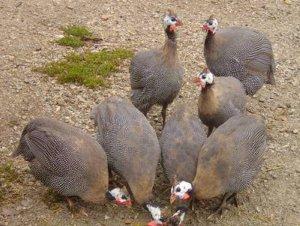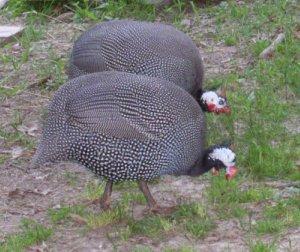Our Guineas

These very noisy birds look like a bunch of AWOL army helmets as they run across the yard. They are said to be good for controlling the Lyme Disease-bearing deer tick. I don't know any research on this, but lots of folk believe it and I sure hope it's true. They certainly range well and eat lots of small things. In fact, if you keep bees, you don't really want to keep guineas. They'll stand by the hive and snap up the bees as they come out. I haven't yellow jacket nests out in the field since I've had these birds.
Guineas often lay their eggs out in the fields and hatch their young by themselves. If you do find the eggs and wish to incubate them, the time period is 26 to 28 days and you treat them like chicken eggs. Young guineas are called "keets." Being native to dry areas of Africa, they are very susceptible to dampness during their first two weeks, and can die from following the mother through dewy grass. After two weeks of age, they are probably the hardiest of all domestic land fowl.
Sexing guineas is not easy to do by looking at the birds, although in older adults the helmet and wattles of the males are usually larger. The easiest way to sex them is by voice. Both males and females make a single syllable, machine-gunlike alarm call, but only the females have a two syllable call. It sounds like they're saying "buck-wheat."
When you get new guineas, don't let them out right away or they may well
disappear down the street. The best way to acclimate them is to pen them
where they can see
the area where they'll be living. After they've been penned a week or two, let one out.
Guineas hate to be alone, so that one won't go far, but it will learn its way
around your place. After a few days, let another out to run with it. If they stay around
it's usually safe to let the rest out soon thereafter. I use this same method with Peafowl,
letting a new hen out before the male as the hens are more social.
For Sale

Mature Guineas $10.00 Each
